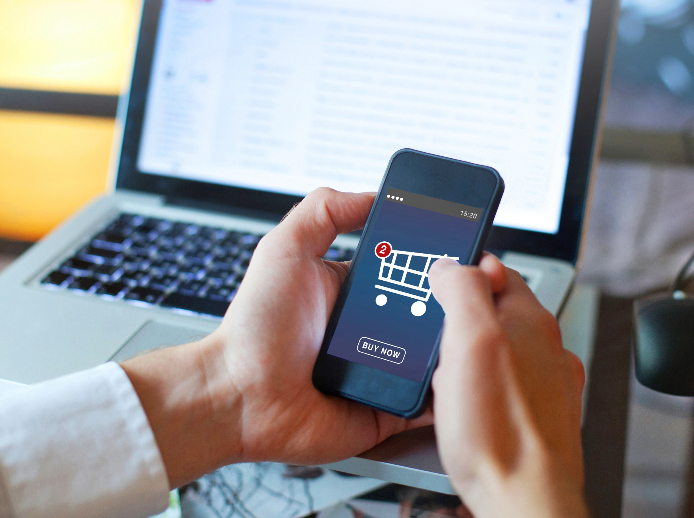How to create a shopping app for retail business
In the past, mobile shopping was considered attractive and convenient. However, online shopping has become a necessity for many people in the last couple of years.
Due to the popularity of e-commerce and shopping apps, many traditional retail companies are now creating applications so that their customers can have the opportunity to order online.
With this need in mind, we will explain the advantages of a customized retail shopping app and give you a step-by-step guide to developing it.
Advantages of sales apps for the retail sector
Before discussing functionalities and the process of developing retail shopping apps, let's discuss their advantages.
Custom app development provides unique and additional benefits compared to standard software. Here are some of them:
Customization:
The most significant advantage of a custom shopping application is that it allows you to create what the business needs and scale the product the way you prefer.
It also gives freedom to choose any design, the functionalities according to the user, and the technological architecture.
Speed
Speed is the most crucial factor for customers when using a shopping application.
A custom shopping application speeds up the whole experience because the architecture has design features according to the customers' specific needs.
When creating a custom application, you can also invest in cross-platform technologies such as Flutter, which can dramatically improve the speed and performance of the application.
Convenience
The best thing about a custom shopping app is its convenience: it saves time and saves the customer from having to travel to a store.
In custom app development, you have the advantage of creating a UX design that focuses on your business goals and considers the best end-user experience.
Customer data
A custom app can give you insider information about customer data, information that is otherwise difficult to collect.
This data can include details about the devices shoppers use, the type of products they purchase, their behavior, habits, and preferences.
Special offers and higher conversion rates
Another advantage of a personalized app is the ability to give targeted offers and discounts to a specific group of users.
Online shopping applications have an insight into customer data that other applications available on the market rarely provide. Based on that information, it can offer tailored promotions that fit the shopper's needs.
You can also incorporate various algorithms into the customized application to predict what products your customers are currently interested in or what drives them to choose a specific product.
These personalized offers and automatic notifications increase conversion rates and, consequently, your revenue.
How to build a retail shopping app
So, are you finally ready to delve into building a retail app?
In the following step-by-step guide, we tell you what you need to consider:
Step 1: team building
There are several ways to put together a team for mobile app development.
Some companies put together a traditional in-house team, even if this is not their business model.
You can also outsource to an external company that can help with services such as business analysis, team management, and staffing.
But whichever path you choose, remember to plan for schedules, budgets, technology requirements, and the number of employees needed before looking for a provider.
Some roles needed to develop a successful retail shopping app are UX, UI, digital strategist, UX research, business consultant, back-end developer, mobile developer, data analyst, and quality assurance (QA).
Depending on the complexity of the application, a larger team with different specialties may be required
Step 2: Market analysis and UX research
Creating a retail application for online shopping is like starting a business: a thorough market study must be conducted to analyze competitors and understand what the user needs.
This process includes researching the target audience, demand, trends, sales, and marketing strategies that would work.
At this point, user research is essential for a realistic idea when designing the prototype of the solution being built.
A user-centered design allows you to understand users deeply.
UX researchers use various methods, such as interviews, surveys, field studies, or focus groups to identify problems and opportunities.
This information serves as the basis for creating a relevant and satisfying application.
Step 3: development of the user interface and definition of functionalities
After the research phase, the next step is to create the user interface. This step is the moment when the functionalities are defined.
It is best not to saturate yourself with a comprehensive wish list. It is better to start with the functionalities that add the most value and then move on to others that enhance the experience.
Reduces the possibility of error
One argument against this type of tool is that they are not 100% infallible and that an error of interpretation, say, in a handwritten line of text, could mean denying a loan and, as a consequence of that failure, losing the customer.
The good news is that AWS tools can indicate the confidence level with which they were able to extract the information from a document field. Based on that confidence level, a manual review instance can be created to minimize the chances of error.
Similar examples can be found in any company where processes require processing documents.
The advantages and flexibility they include can also be seen in how these tools are paid.
You pay for what you use
Unlike "out of the box" tools that often require significant upfront investments, document processing and analysis tools, such as those from AWS, are paid per page processed.
Pay-as-you-go also allows you to experiment and ensure that the selected tool works to meet your organization's needs. Services such as AWS also include a free layer that can be used for testing and is ready to go straight out of the box and designed to solve specific issues.
Finally, it is worth noting that any company that has processes in which it is necessary to digitize or process documents has the possibility of saving time and reducing costs through these types of tools. The key is to approach them, keeping in mind that the more flexible they are, the better they will adapt to the particularities of each organization while positively impacting the user experience.
These are some of the most common ones in retail applications:
- Product availability monitoring.
- Quick checkout.
- Order management.
- Advanced mass shopping.
- Booking time slots for a store visit and then picking up the product.
- Real-time GPS tracking of online orders
- Easy and secure payments.
- Easy to use content management system.
- Promotions, offers, rewards.
- Card data security.
- Payment gateway integrations.
- Product labels for different allergens.
While the success of an online shopping application depends on many factors, incorporating all of the above functionalities will certainly give the application a good edge.
Step 4: develop, test, deploy and maintain
As you progress with the development and implementation of the retail app, ensure you meet all the technical requirements.
Also, whether you are designing the app for Android or iOS operating systems, it is essential to implement debugging to eliminate all issues before deployment.
Once the app is up and running, it will require constant maintenance and debugging to run smoothly.
Step 5: Create an MVP
Before investing everything entirely in the development process, it is common practice for startups first to create a minimum viable product.
However, this is an optional but essential step.
Creating the MVP ensures you are not putting all your eggs in one basket.
Instead, it gives you a better idea of how the target audience will receive the app, what changes need to be incorporated, and what improvements need to be made to the final functionalities.
Step 6: Promotion and marketing
There is no point in creating an excellent grocery delivery app if you can't market it efficiently.
Promoting and marketing your app is the most crucial step in your mobile e-commerce journey.
Consider advertising your product on App Store and Google Play. Also, creating a landing page with an accurate call to action, a visible logo, and a promotional video showing how your app works will do wonders in promoting your app.
You can also create a blog for your app. An app content page always increases traffic, which helps you get more visitors to your app page.
Ready to transform your retail business with a custom shopping app? Our expert team can guide you through every step of the development process.
Share this
You May Also Like
These Related Stories

How to Build an App for Grocery Shopping

AWS Textract: Automate Document Processing and Transform Your Business

Outsourcing: four strategies to stay stable in a crisis
Subscribe to
Pragma Blog
You will receive a monthly selection of our content on Digital Transformation.

